|
Printables |
PowerPoints |
Online exercises |
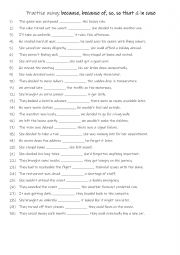
|
A2-B1 Practise using: because, because of, so, so that & in case 1
Learning to use "because," "because of," "so," "so that," and "in case" helps improve clarity and precision in communication. These phrases allow you to explain reasons ("because," "because of"), show results ("so"), indicate purpose ("so that"), and talk about future possibilities ("in case"). Mastering these structures enhances your ability to pr...
Level: elementary
Age: 8-100
Type:
Downloads: 106
|
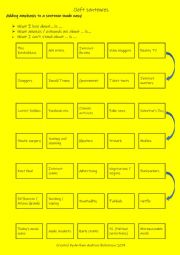
|
Adding emphasis to your opinion
Using cleft sentences to add emphasis to your ideas / thoughts. All the topics / themes are of current interest to stimulate conversation.To help develop conversational skills for B1 students, get the students to give examples to support their opinions.
Suitable for both pairwork and small groups.
Level: intermediate
Age: 14-100
Type: worksheet
Downloads: 273
|
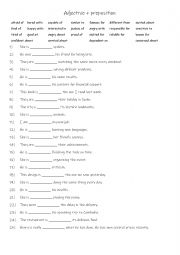
|
A2+-B1 25 Adjective + prepositions
Understanding how adjectives combine with prepositions helps students provide more detailed and precise descriptions. For example, knowing the phrase �interested in� allows you to convey specific interests more clearly.Mastering these combinations contributes to overall language proficiency, allowing you to use English more accurately and confident...
Level: intermediate
Age: 10-100
Type:
Downloads: 117
|
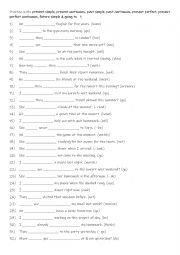
|
A2+-B1 Practise with present simple, present continuous, past simple, past continuous, present perfect, present perfect continuous, future simple & going to 1
Students should practise these tenses to communicate effectively across different time frames. The present simple and present continuous handle current actions, habits, and temporary events, while the past simple and past continuous are essential for narrating completed and ongoing past actions. The present perfect connects past actions to the pres...
Level: elementary
Age: 9-100
Type:
Downloads: 120
|
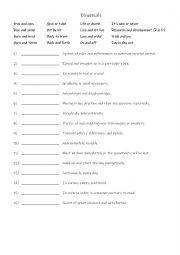
|
Binomials - common pairs of words 1b
Students read the definitions and match them with the correct pair of words.These pairs are often used for their rhythmic and memorable qualities, making the language more engaging and easier to remember.In English grammar, binomials are expressions where two words are joined by a conjunction (usually "and" or "or") to form a fixed phrase. These wo...
Level: intermediate
Age: 12-100
Type: worksheet
Downloads: 117
|
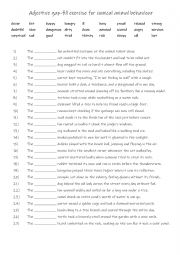
|
A2+ - B1+ Adjective gap-fill exercise for comical animal behaviour
Students familiarise themselves with the 27 adjectives. Then they read the sentences to see which adjective is needed to complete the gap-fill. Answers on page 2.
Level: intermediate
Age: 9-100
Type:
Downloads: 116
|
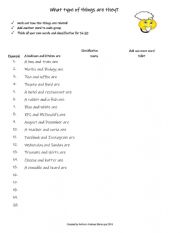
|
Word association
This worksheet is suitable for A2 level young learners.A great way for students to group vocabulary and see the association. It can be used in pairwork, small groups or individually.
Level: elementary
Age: 8-100
Type:
Downloads: 129
|
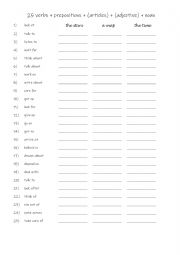
|
Collocations - 25 verbs + prepositions + (articles) + (adjective) + noun
Overall, mastering verbs + prepositions (and related word combinations) can significantly improve your language skills, making you a more effective communicator in both spoken and written contexts.Using collocations correctly makes your language sound more natural and fluent. Native speakers often use specific combinations of verbs, prepositions, a...
Level: intermediate
Age: 10-100
Type:
Downloads: 120
|
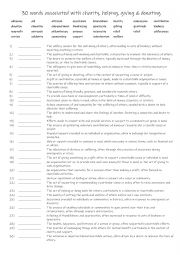
|
B1+-C1 30 words associated with charity, helping, giving & donating
Learning words associated with charity, helping, giving, and donating is crucial for enhancing understanding of social issues and the various ways to contribute to positive change. These terms improve communication about charitable activities, raise awareness of nonprofit work, and inspire individuals to get involved through volunteering or advocac...
Level: intermediate
Age: 8-100
Type:
Downloads: 112
|
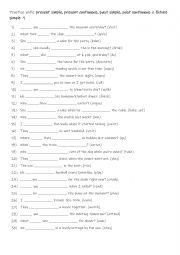
|
A1-A2 Practise with present simple, present continuous, past simple, past continuous & future simple 1
Students need to use present simple, present continuous, past simple, past continuous, and future simple to communicate effectively and express time-related ideas clearly in English. The present simple is used for routines, habits, and facts, while the present continuous describes ongoing or temporary actions. The past simple narrates completed eve...
Level: elementary
Age: 8-100
Type:
Downloads: 111
|
|
|
|
|












